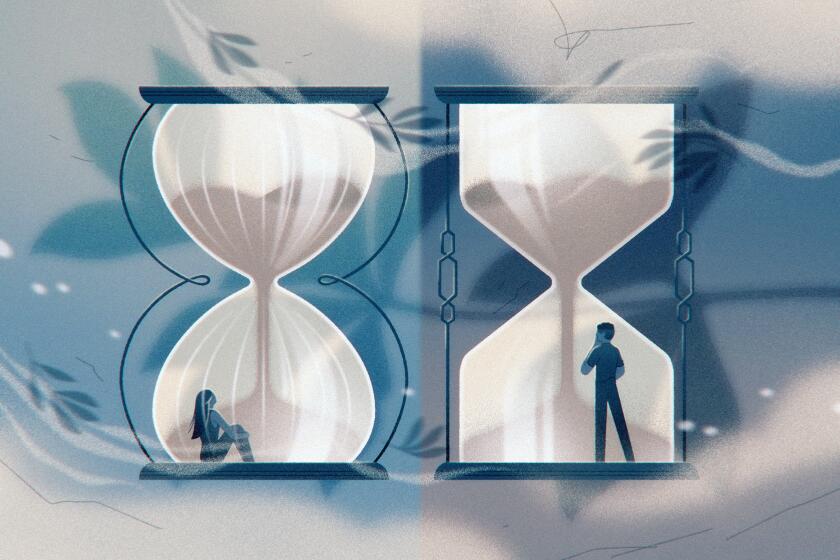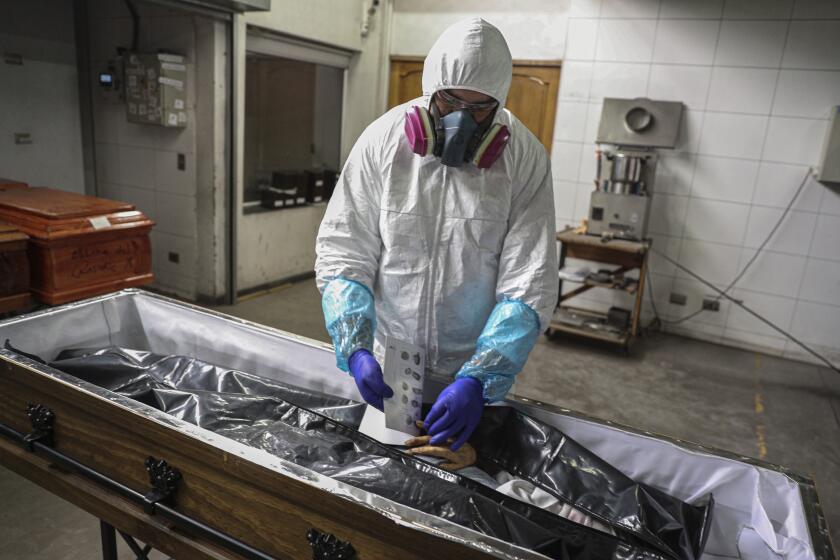GOOD HEALTH MAGAZINE : Psychology : AT RISK : OF PRUDENCE AND PERIL: WHY SOME TAKE CHANCES AND OTHERS FEAR TO TREAD
Everything is sweetened by risk,” observes a 19th Century treatise on the fear of dying.
Well, perhaps not everything. The pleasures of sunbathing, for example, do not increase with the realization that the sun’s ultraviolet rays can cause skin cancer.
But risk, in other forms, seems to have partakers who are more avid than others--people who get a certain charge out of performing acts that pose physical, social or financial peril. In itself, risk is not the prime motivation for behavior that the more timid among us might deem as crazy, according to psychologists. Rock climbers and tightrope walkers don’t harbor a secret death wish; venture capitalists don’t invest in start-up businesses because the majority of enterprises fail within the first five years; struggling artists don’t persist because their works are ignored by critics. Yet, because of the lurking potential for failure and even disaster, most of us steer clear of such pursuits.
“I don’t think anybody engages in risk taking just for the sake of it,” says Louis J. West, UCLA professor of psychiatry. “What we describe as ‘risky’ is a value judgment placed on somebody else’s behavior.”
Psychologists and other researchers note that people vary greatly in their tolerance for life’s “sweetener” and the uncertainty that, by definition, risk carries. Those who have a powerful hunger for variety and intensity of experience do have fears, says University of Delaware psychologist Marvin Zuckerman. But they appraise risks differently than people who are strongly drawn to the predictable and who receive ample stimulation from familiar surroundings and routine activities.
“The attitude of the high-sensation seekers,” Zuckerman wrote in an article published in 1988, “seems to be: ‘Yes, it’s risky, but everything will turn out fine for me, and I will feel good.’ The attitude of the low-sensation seeker is: ‘Everything bad that can happen will happen, and I will be devastated.’ ”
Evidence from several lines of research suggests that some of those who cross to the “wild side” of the fuzzy boundary of conventional behavior may have an inherited biochemical predisposition that makes them more likely to take risks. Moreover, the further one’s behavior moves him or her away from that boundary, according to emerging theories, the closer he moves to the clinical domain of manic-depressive illness, a biochemically-based disorder characterized by marked swings between extreme elation and deep melancholy. Finally, there are indications that the willingness to take risks is a critical psychological link between the need for exhilarating physical or mental experiences and the drive to create.
Whatever the basis for risk taking, determining why one individual will spend a Sunday afternoons kayaking in the seething rapids of a river while another person regularly opts for a lawn chair and the newspaper may say much about who we are as individuals.
Using scales that measure, for example, “sensation seeking,” “thrill seeking,” “monotony avoidance” and “constraint,” researchers have found that the propensity to engage in physically or socially risky acts is deeply--perhaps biochemically--ingrained in one’s personality and may even be inherited. Zuckerman has spent 25 years studying “sensation seekers,” using a composite scale that measures the “need for varied, novel and complex sensations and experiences and the willingness to take physical and social risks.” He says some forms of mania resemble “sensation-seeking behavior that is out of control.” Even when their disorder abates, manic depressives rate high in sensation seeking, according to Zuckerman’s research. Other studies have found that the brains of people who suffer bouts of mania are biologically similar to those of normal sensation seekers.
In sensation seekers, Zuckerman suggests, fluctuations in the distribution of chemical messengers, or neurotransmitters, and other compounds may alter the brain’s regulatory mechanisms. One consequence, he says, may be that higher levels of stimulation are needed just to trigger the brain’s internal reward system. That may account for the reason that high-sensation seekers run inordinately high risks of using cocaine or other stimulant drugs.
Also implicated in sensation seeking--particularly in males who seek stimulation through drinking, partying, gambling and sexual variety--are high levels of male sex hormones, Zuckerman says. The hormones’ suspected influence may account for the greater prevalence of sensation seeking among males, especially adolescents and young adults.
Perhaps the most compelling evidence for a biological underpinning of risk taking comes from the University of Minnesota’s large-scale study of identical twins who were raised apart. The Minnesota scientists concluded that about half of our personality is inherited, with the remainder shaped by the family, peers and other environmental influences. Particularly strong was the correspondence between twins for the personality trait that corresponds closely to sensation seeking. Nearly 60% of the time, a twin who was impulsive and reckless, enjoyed dangerous kinds of activities and questioned authority had an identical counterpart who shared those and other traits that are the hallmarks of sensation seeking.
Sometimes the similarities bordered on the uncanny. Consider Jerry Levy of Tinton Falls, N.J., and Mark Newman of Paramus, N.J., 65 miles away. Separated five days after birth and unaware of each other’s existence, the identical twins were reunited at age 31. Among their many shared traits was a love of motorcycles, a raucous joviality and an avocation that ranks high on any risk-taking scale: Both are volunteer firefighters.
“A clear streak of wildness runs through some of the twin pairs,” Tellegen says. “Of course, the opposite (shared high levels of caution and a preference for the routine rather than the adventurous) is also true. I think it’s good for the species to have people on both sides.” People who are driven by a desire for the novel and exciting and, as a result, the risky, may blaze new paths, he says, but they may not be the kind of people you want working in a nuclear power plant or “steering an oil tanker from port to port.”
If one accepts--and not everybody does--the theory that some people are more predisposed to taking risks than others, an important question remains: What do they get in return? One pay-back may be a feeling of euphoria. From reports of cliff divers and others, “we know that taking enormous risks often translates into tremendous highs,” says Lewis P. Lipsitt, a Brown University psychologist who is studying infants and children to identify factors that may foster risk-taking or inhibition later in life. “We also know that some people need a sense of risk in their sexual encounters. For them, the threat of ‘getting caught’ has an enhancing effect.”
Or it may be that some people engage in risky activities just to achieve a normal state of arousal, suggests the University of Wisconsin’s Farley, who has devised a series of measures to assess “thrill seeking.” A barrage of sensory signals--having the stereo on while talking on the telephone and simultaneously paging through a magazine--may be more than most people can handle. But those who rate high on Farley’s thrill-seeking scale--he calls them Big Ts--may need all this stimulation to “rev up an under-aroused nervous system.”
Although not wedded to the arousal concept, Farley has found that Big Ts tend to be “experimenters with life,” exploring and seeking variety in everything from their surroundings to their sex lives. Their curiosity, he says, is aided by an ability to think concretely and abstractly, fostering high levels of creativity, which Farley has observed among many of the thrill seekers he has studied.
The work of Farley and Zuckerman closely parallels new research on the sources of human creativity. ‘Someone who does something new is a minority of one,” says psychiatrist Ruth Richards, who with psychologist Dennis Kinney developed a scale to measure how creative people are in their jobs and hobbies. As a result, creative individuals often must be willing to face the chances of failure and the potential for social disapproval, she adds.
“Even in fields that ostensibly value creativity--the arts and the sciences--true creativity challenges the status quo and carries the risk of getting punished or ostracized,” says Kinney, who along with Richards is a staff member of the McLean Hospital in Belmont, Mass., and the Harvard Medical School.
Since the 1970s, researchers have been exploring the origins of human creativity, following up on anecdotal evidence that many eminent writers, composers and other artists suffered from manic-depressive illness. Examples include writers Ernest Hemingway, Virginia Woolf, Herman Melville, Edgar Allan Poe, F. Scott Fitzgerald and Lord Byron. Among composers, Handel, Mahler and Tchaikovsky were known to have mood disorders.
Studies of living artists strongly indicate a biochemical connection between creativity and manic-depressive illness. Extraordinarily high rates of the disorder--usually a third or higher--have been found in samples of top artists.
Richards and Kinney took a different tack. Instead of studying acknowledged artists, they concentrated on people who are creative in more common pursuits. Their findings add a twist to the link between creativity and mood disorders. People who are most creative in their everyday lives, according to the research, are not individuals who suffer from the full-fledged disorder but rather those who experience milder mood swings or are simply members of a family with a manic-depressive member.
The scientists suggest that in exchange for a presumed genetic risk of developing a mood-swing disorder--shared by up to 15 million Americans, according to some estimates--these people are equipped with a “compensatory advantage” of creative potential. The result, Richards speculates, is a “richer thought process, greater emotional awareness, and motivating energy.”
Whether these individuals tap this apparently innate reservoir of creativity may depend on their propensity to take risks. Those who do, Richards suggests, may already view themselves as standing outside of mainstream society and may be more willing to experiment with novel ideas. Or, she says, the drive to create may generate internal rewards that are reaped during the process of creating.
While risk taking can be healthy, it has a dark side, destructive to the individual and sometimes to society. The most reckless forms of behavior, however, may not have anything to do with the willingness to take risks but are a denial of fear. UCLA’s West classifies Russian roulette, playing chicken on the highway, and other seemingly irrational, lethal behavior as “counterphobic.”
“The motivation behind this kind of behavior is to prove to oneself and to others that you are not afraid,” he says. “The more fear one has, the more powerful the ‘counterphobic’ force to deny it. Denying one’s timidity results in foolhardy behavior of the worst kind.”
Still, much of what is regarded as destructive behavior may stem from the need for stimulation through socially unacceptable activities. Both Zuckerman and Farley contend that a strong desire for excitement, which tends to decline in adulthood, may be a major factor in juvenile delinquency. Without constructive outlets, they speculate, boys and young men are more apt to engage in criminal behavior.
“It’s unrecognized how much of a role sensation seeking plays in juvenile delinquency,” Zuckerman contends.
In an unpublished study, Farley and his associates found that thrill seekers were about twice as likely to be involved in automobile accidents than those who rate low on his scales. Combining this disparity with the tendency of young thrill seekers to drink alcohol and use drugs, Farley suggests that efforts to improve highway safety would be more successful if they were tailored to the individuals behind the wheel.
“We lowered and then raised the drinking age; yet accidents are the No. 1 cause of death among teens and young adults,” he says. “Psychology has helped us understand and address problems at other stages of life, but we haven’t done this with adolescents. Adolescents are dying of their own behavior. It’s a psychological problem, and we should treat it that way.”
In another study, Farley found that thrill seekers from high-income families tended to find stimulation in socially acceptable outlets. Thrill seekers in the lower income groups were more likely to be involved in delinquent activities. The findings, Farley says, suggest that the difference between constructive and destructive risk taking may be a matter of whether families and social institutions are able to provide safe options, such as sports, for satisfying one’s need for stimulation.
Other researchers approach risk taking by studying the cognitive processes by which one makes decisions. These investigators view the situation somewhat differently. Baruch Fischhoff of Carnegie-Mellon University, for example, concedes that some people may be more willing to take risks than most, but he contends that “people behave differently on a lot of different dimensions. They may be cautious at work, for example, but not at home.”
Adds John Payne, a professor of business administration at Duke University, who studies how businesses handle risk, “I think there’s more to be understood by looking at the environment in which people are working,” rather than at personality differences. To support his view, Payne notes that middle-level managers tend to be “more risk-averse and worry more about the probability of failure” than their superiors, and that businesses are more likely to take risks during bad times.
Fischhoff, now involved in a major study of how adolescents make decisions, says the difference between reckless risk taking and constructive risk taking is often the amount of information people have and how they process that information. Like the adults he has studied, Fischhoff has found that youths tend to “overestimate their knowledge” of risks and underestimate the potential dangers of particular behaviors.
Overall, however, “kids know a lot,” he says. “Where they fail is putting information together to make decisions.”
Regardless of their disciplinary perspectives, researchers agree that some degree of risk taking--what most of us would call calculated risk taking--is beneficial. Experimenting, exploring options and seeking out new experiences can enrich life, they say.
Without some risk taking, an individual becomes “trapped in a single perspective,” says Ellen Langer, Harvard University psychologist and author of the book “Mindfulness.” “You’re in a rut and don’t even know it.”
Langer and other experts aren’t recommending that people set out immediately to scale a mountain peak, or that they go into work tomorrow and demand a raise from their curmudgeonly boss, although, for some, such risk taking might be appropriate. Risk can be taken in doses, big and small.
“If you always eat at the same restaurant, you’ll never discover a new one,” Fischhoff quips. “You’ll never find out that you like Thai food.”



